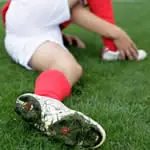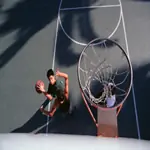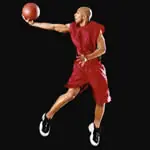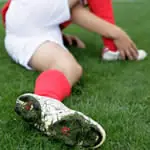Frontcourt
The two officials on the court are referred to as the lead official and the trail official. The lead official, or the lead, is the official in a halfcourt setting normally positioned along the endline and is primarily responsible for the play under the basket and in the lane area. The trail official, or the trail, is the official in a halfcourt setting positioned near the sideline opposite the lead and is responsible for perimeter and backcourt play.
Generally, in a halfcourt setting:
The trail's on-ball responsibilities include the area above the free-throw line extended opposite the trail to the division line and from the three-point arc to the sideline on the trail side of the court.
When the trail is on-ball, the lead's off-ball responsibilities include the area below the free-throw line extended, including the lane, out to the three-point arc on the trail side of the court. You never want both officials watching the player with the ball at the same time. When that happens, no one is watching the other players.
The lead's on-ball responsibilities include the area below the free-throw line extended and the lane up to the far edge of the backboard (away from the lead) to the sideline nearest the lead.
When the lead is on-ball, the trail's off-ball responsibilities include the area above the free-throw line extended to the division line and the lane from the near edge of the backboard (nearest the trail) to the sideline nearest the trail.
The trail has a much better look on drives to the lane that start on the trail's half of the court when the lead is on the far side of the court.
By aggressively penetrating toward the endline when players drive the lane, the trail can take some of the pressure off the lead by being in great position to judge the play. The trail must get off the sideline to officiate those coverage areas correctly. It takes a lot of movement and an understanding of good angles. Proper coverage requires good eye contact and a "feel" for where your partner is looking.
Backcourt
When play moves from one endline toward the other, the trail has primary responsibility in the backcourt.
In any transition, effective coverage means significant movement by the trail. Similar to halfcourt coverage, the trail must move off the sideline. When there's defensive pressure in the backcourt, sometimes the lead must help.
There is a general rule when the lead helps the trail in the backcourt. If there are four or fewer players in the backcourt, the trail works alone there. More than four players, the lead helps.
When there's more than four players in the backcourt, the lead is positioned near the division line. If all the players are in the backcourt, the lead may move closer to the backcourt endline for better angles. If some players are in the frontcourt, however, the division-line area is the best position.
When near the division line, the lead must stay wide and constantly glance from backcourt to frontcourt. That "swivel" glance allows the lead to help the trail with backcourt traffic plus watch players in the frontcourt.
Generally, in a fullcourt setting:
The new trail is responsible for the backcourt endline and for the sideline opposite the new lead.
The new lead is responsible for the frontcourt endline.
The sideline opposite the trail in the backcourt is a shared responsibility.
Free Throws
Positioning
The lead watches players on the opposite lane line (closer to the trail) for potential violations, etc. The lead also watches the lane space nearest the endline on the lane line nearest the lead. The lead stands off of the court, slightly behind the players on the lane with the lead's back to the bench.
The trail watches players on the opposite lane line (closer to the lead) except the opposite low block area (which is now watched by the lead). The trail watches the free thrower and has secondary coverage including all the players behind the free-throw line extended. The trail is always positioned facing the scorer's table and is halfway from the lane line and the sideline.
Movement
The lead steps in the lane, signals the number of free throws, bounces the ball to the shooter after checking that all the players are set along the lane and backs out to the lead's position along the endline. The trail signals the number of attempts to the scorer's table and visibly has a 10-second count with hand farthest from the basket. When the last free throw is in the air, the trail raises the farthest hand from the basket and takes a step toward the endline. If the free throw is successful, the official lowers the raised hand. If the free throw isn't successful, the official uses the "start the clock" signal when a player touches the ball.
Throw-ins
Proper throw-in administration is critical to ensure your games run smoothly. There are probably more unwanted game interruptions during throw-ins than during any other segment of the game. Efficient movement and strong communication by the officials gets the ball back in play quickly and correctly.
Throw-in spots
Stoppages of play inside the key circle, plus the area from the free-throw line corners to the endline corners and below, result in throw-ins along the endline nearest the stoppage of play. Stoppages of play outside that area result in throw-ins along the sideline nearest the stoppages.
The lead administers all throw-ins on the frontcourt endline. When the lead administers:
The thrower is always between the lead and the thrower's goal.
The trail is positioned between the free-throw line extended and the division line nearest the sideline opposite the lead, ensuring both sidelines, both endlines and the division line are covered.
The trail administers all throw-ins on the sidelines and the backcourt endline. When the trail administers the throw-in in the frontcourt:
The thrower shall be between the trail and the frontcourt basket.
Unless otherwise dictated by an anticipated play, the lead is positioned on the endline on the opposite side of the court from the trail, ensuring both sidelines, the frontcourt endline and the division line are covered.
When the trail administers the throw-in in the backcourt:
The thrower is always between the trail and the thrower's goal.
Depending on backcourt pressure, the lead is positioned near the division line on the sideline opposite the trail, ensuring both sidelines and both endlines are covered.
Reminders for officials administering throw-ins:
Hand the ball to the thrower with the inside hand (closest to the thrower). Don't bounce it.
Move away from the thrower to avoid straightlining. Take at least one step laterally away from the thrower so your field of vision increases.
Take a step back from the endline or sideline, increasing visual clearance and assuring proper perspective.
Use the boxing-in method where the player inbounding the ball (and likely most of the players on the floor) should always be between the two officials.
Jump Ball
The jump ball sets the tone for the rest of the game. It's the first action directly related to the game and that first impression can be a lasting one. With a good toss, you've started the game off properly.
Remember these points during jump ball administration:
Before administering the jump ball, check with both team captains to ensure both teams are ready.
Make sure your partner is ready.
Blow the whistle outside the jump ball circle before entering.
Make sure your elbow is directly below the ball and perpendicular to the floor to ensure a straight toss.
Place your foot between the jumpers' pivot feet to create space.
Keep the ball at your side.
Bend your knees slightly; using your leg strength will help toss the ball high.
For a one-handed toss, keep your palm open to the sky to ensure a wrist spin doesn't create a bad toss.
The toss should be straight and slightly higher than the players can jump so the players tap the ball on the way down.
If you practice the jump ball toss, your games will get off to a good start.






Discuss This Article